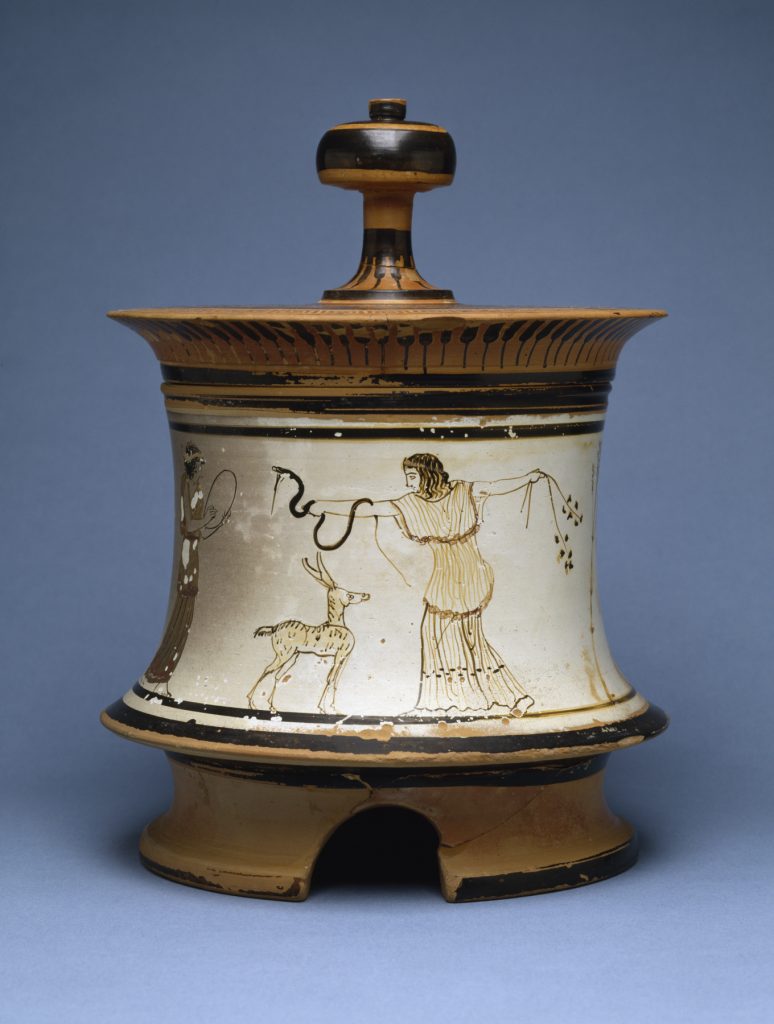The Ancient Greek Hero in 24 Hours[1] is based on a course that Professor Gregory Nagy has been teaching at Harvard University since the late 1970s.
The book discusses selected readings of texts, all translated from the original Greek into English. The texts include the Homeric Iliad and Odyssey; selected Homeric Hymns; the Hesiodic Theogony and Works and Days; selected songs of Sappho and Pindar; selections from the Histories of Herodotus; the Agamemnon, Libation Bearers, and Eumenides of Aeschylus; the Oedipus Tyrannus and Oedipus at Colonus of Sophocles; the Hippolytus and Bacchae of Euripides; and the Apology and Phaedo of Plato. Also included are selections from Pausanias and Philostratus. It is divided into 24 chapters, 24 Hours, each exploring one or several topics.
This series of galleries attempts to illustrate each Hour with visual art. We will have 6 galleries corresponding to 4 hours each. This sixth gallery covers Hours 21–24.
For Gallery 1 see here, for Gallery 2 see here, for Gallery 3 see here, for Gallery 4 see here, and for Gallery 5 see here.
Image credits
Theater of Dionysus Athens
Photo: sailko Creative Commons Attribution-Share Alike 3.0 Unported license via Wikimedia Commons
Pyxis with Maenads Sotheby Painter, Greek, active circa 480-450 BCE
Creative Commons Zero: No Rights Reserved The Walters Art Museum
Maenad, fragment of an Attic red-figure cup, ca. 480 BCE, Louvre
Photo: Marie-Lan Nguyen, public domain, via Wikimedia Commons
Yellow room in the House of the Vettii: center panel of Pentheus being torn apart by Maeads (detail)
Photo: Lady Erin Creative Commons Attribution-NonCommercial-NoDerivs 2.0 Generic (CC BY-NC-ND 2.0) via Flickr
Pentheus torn apart by Agave and Ino. Attic red-figure lekanis (cosmetics bowl) lid, ca. 450-425 BCE, Louvre
Photo: Jastrow, public domain, via Wikimedia Commons
Socrates: Marble bust, Roman copy of a Greek original, Montreal Museum of Fine Arts
Photo: Kosmos Society
Detail of the “Thera Flotilla Fresco”
Public domain via Wikimedia Commons
Crane, Walter: “He drank the contents as though it were a draught of wine,” illustration from Macgregor, Mary The story of Greece told to boys and girls,.
Public domain, via Wikimedia Commons
David, Jacques Louis, The Death of Socrates 1787. The Metropolitan Museum of Art.
Public domain, Metropolitan Museum of Art
State Prison, Agora, Athens: information plaque
Photo: Kosmos Society
Site of State Prison, Agora, Athens
Photo: Kosmos Society
Black–glazed medicine bottles perhaps used to hold the hemlock, Agora Museum, Athens
Photo: Kosmos Society
Terracotta alabastron (perfume vase), with rooster, c 620–590 BCE, Greek, Corinthian. The Metropolitan Museum of Art
Public domain, Metropolitan Museum of Art
Rooster, Boetia c 500 BCE, Martin von Wagner Museum, Würzburg, Germany
Photo: Daderot, public domain, via Wikimedia Commons
Asklepios. Pentelic marble, found in the Sanctuary of Asklepios at Epidauros, copy of an original of the c4th century BCE, National, c160CE, Archaeological Museum in Athens
Photo: Kosmos Society
Statue of Dionysus. Marble, 2nd century CE (arms and legs were heavily restored in the 18th century). Louvre.
Photo: Marie-Lan Nguyen, Creative Commons Attribution 2.5 Generic license via Wikimedia Commons
Dionysus on boat turning pirates into dolphins North African Roman mosaic, Bardo National Museum, Tunisia.
Photo: Dennis Jarvis, Creative Commons Attribution-Share Alike 2.0 Generic license. via Wikimedia Commons
Exekias: Dionysus in a ship sailing among dolphins. Attic black-figure kylix, c 530 BCE. Vulci. Staatliche Antikensammlungen.
Photo: MatthiasKabel. Creative Commons Attribution-Share Alike 3.0 Unported license. via Wikimedia Commons
Raffaello Sanzio da Urbino: The School of Athens. Vatican
public domain, via Wikimedia Commons
Note: Images have been selected from pictures that are freely available with open source or Creative Commons licenses, or (attributed to “Kosmos Society”) from photographs sent in by community members for the purpose, used with permission. The images in this post are intended to suggest the subject, rather than illustrate exactly—as such, they may be from other periods, subjects, or cultures. Attributions are based where possible by those shown by museums, or on Wikimedia Commons or Flickr, at the time of publication on this website.
Images accessed June 2019.
[1] Nagy, Gregory. 2013. The Ancient Greek Hero in 24 Hours. Harvard University Press, Cambridge, MA: 2013. Available online at CHS.
https://nrs.harvard.edu/urn-3:hul.ebook:CHS_NagyG.The_Ancient_Greek_Hero_in_24_Hours.2013
____
Hélène Emeriaud, Janet Ozsolak, and Sarah Scott are members of the Kosmos Society.


















